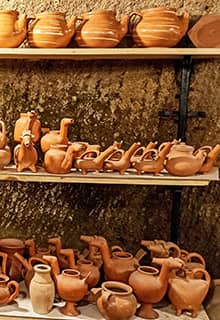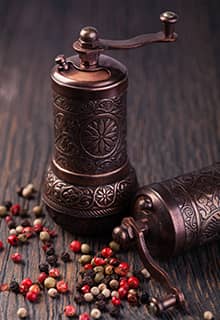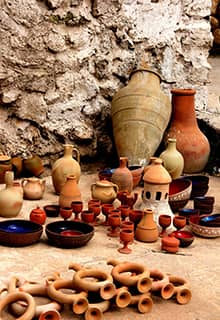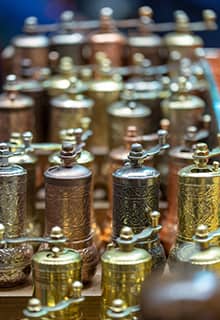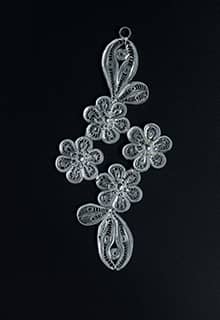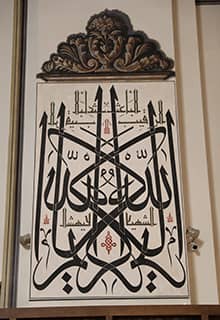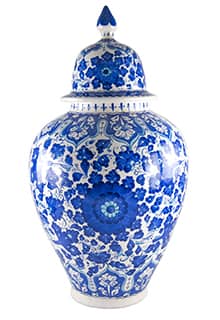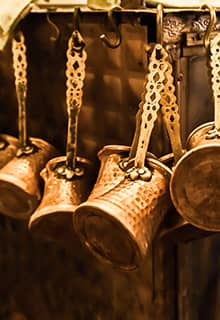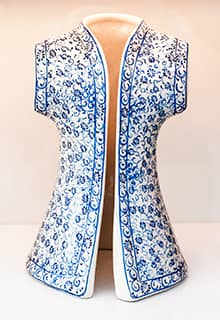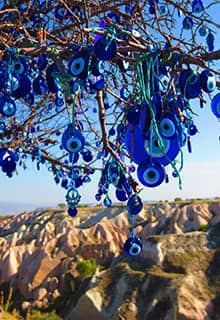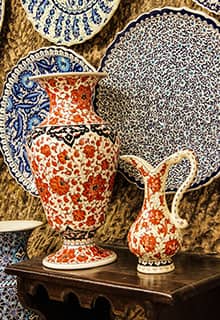Turkish Handcrafts worth looking out for
in Türkiye
Ceramics
The art of ceramics (seramik eşya) in Anatolia reached its highest level of technique and aesthetic during the Seljuk and Ottoman periods. In the 17th century, Iznik became an important tile production centre of the Ottoman Empire. The motifs used on tiles are mostly: tulip, hyacinth, pomegranate, carnation, hashish and çintemani,(Chintamani) motifs were used on tiles. The Turkish word, çintemani, appears to be derived originally from Sanskrit, chinta mani, meaning “auspicious jewel”. In addition, animals like birds, fish, rabbits and dogs plus human and ship figures were also sometimes used. The most distinctive characteristic of the 16th century Iznik tiles and ceramics is the red colour added to the blue-white background with occasional use of green, turquoise, and black. The plethora of Iznik ceramics includes art pieces such as bowls, vases, plates and tableware as well as the famous tiles used to decorate some of the great Mosques of İstanbul and the Ottoman Empire. Kütahya and Çanakkale also have an important heritage of producing ceramics.
Kütahya is located to the south of İstanbul towards the most easterly part of the Aegean Region. It has been famous for its colourful porcelain objets produced there since the 14th Some fine examples of Kütahya pottery can be seen in the Tiled Kiosk of Topkapı Palace and the Pera Museum in İstanbul, and on the Benaki Museum in Athens. Magdalen College, Oxford, also has a collection. In the town there is a Museum of Ceramics (Çini Müzesi) next to the Great Mosque (Ulu Cami).
Çanakkale is located at the mouth of the Dardanelles, next to the Aegean. The name of the town can be literally translated as “Pottery Castle”. In the 17th C. the popularity of Çanakkale Ceramics was greater than even that of Iznik. The making of Çanakkale ceramics was often a very time-consuming process. They were often painted with over with creamy glazes (usually clear). And they were, very diverse in appearance, including plates, open and closed bowls, long necked bottles, gas lamps, vases, and even animal figurines.
Pottery
Cappadocia is famous for its pottery (çanak çömlek) and there is even a local dish that is cooked in a sealed pot that is cracked open as it is served (testi kebabı). Pottery is used for much of the local tableware, you’ll be drinking from clay goblets poured from ewers made of pottery too! Pottery making is deeply built into the local culture, and manufacturing methods remain close to their ancient Hittite roots. The locals’ relationship with the Kızılırmak River dates back to the Bronze Age. The clay used to make pottery is a mixture of hard clay resources found in the mountains surrounding Avanos, and the softer ones taken directly from the Kızılırmak riverbed.
Since it is not possible to produce quality pottery using only one type of clay (as it would crumble during the process), a special red paste that takes its colour from local soil, is made using both. The paste is kneaded by hand to remove lumps and, once soft, left to rest for a day. The next day, using a foot-driven wheel, the craftsmen shape their clay into various objects, which then are left for a short rest in the sun. Only then, if the design requires, are handles added. If the initial object is left in the sun for too long, there is a chance the handles might not adhere. Next, the surface of some of the objects is painted. Traditionally, natural red dye (yoşa) is used in this process. The objects are left to dry in a special room within the workshop (yanalak), where the firing kilns (pottery furnaces) are also located. Objects to be fired are first exposed to sunlight in order to increase their temperature before placing them in kiln for fumigation and burning. The last part of the manufacturing process takes more than a day in the summer, but in winter the waiting time extends to more than a week. For pottery burning, the kiln temperature should be at exactly 1,200 degrees Celsius, otherwise the clay begins to break. The final step is a 12-hour cooling, moistening and polishing of the objects. These handmade objects will then serve you for many years.
Jewellery
A particularly interesting local art is that of Telkari which is a branch of filigree jewellery that uses very fine wires of gold and silver. Precious stones or small silver balls are also added. The most popular item is a bracelet and a ring combined so the outer part of the hand is covered in a mesh of braiding. As there are examples of filigree work in ancient Mesopotamia that date back 3,000 years it may well be the art of Telkari which originated in the Mardin region in the 15th C is a continuation of a much older tradition.
In other jewellery a wide variety of designs are available to meet the demands of various tastes. The craftsmanship is usually good, but you must inspect each piece to pick the best. It is also possible to design your own jewellery and have it handmade for you with a reasonable price in most big jewellery centres located all over Türkiye. If you are short of time, these centres can send your insured customized jewellery to your home address abroad. When buying silver or gold, be sure to look for the maker's hallmark stamped into an inconspicuous part of the piece, certifying that it is genuine.
Metalwork
Check out ornamented coffee pots and pepper grinders in the local bazaars. Metalwork has an important place in the traditional handcrafts of Türkiye. It was brought from Central Asia to Anatolia by the Seljuk Turks and gained importance during the Ottoman Empire. One of the most used metals is copper. Copper has a very important place in Anatolian art because it is a metal suitable for ornamenting. It has long been used for daily objects such as kitchen utensils and jewellery, and at one by the military to make helmets. In buildings it was used for doors and door ornamentation. There are four techniques that are used in making copper utensils: pounding, moulding, turnery and milling.
Glasswork
There are many examples of glasswork left behind by the various civilizations of Anatolia. Stained glass in various shapes and forms was developed in the Seljuk period. After the capture of Constantinople, the city became a centre for glasswork during the Ottoman period. Cesm-i Bülbül and Beykoz are two of the techniques from that period that still survive today.
Cesm-i Bülbül (lit. “Eye of Nightingale”) is the name of a glass art technique that was invented by Dervish Mehmed Dede of the Sufi Order after he was sent to Venice by the Sultan Selim III, in late 18th century. Mehmed Dede opened a workshop in the Beykoz district of İstanbul. His improvements on the " Filigrano" techniques he studied in Venice, became the “cesm-i bülbül” technique. The “cesm-i bülbül” technique is important because of the special methods it introduced to glass works, as well as the hard work and creativity it requires for its production. Its most outstanding feature is that very thin coloured glass sticks are aligned together and melted at extremely high temperatures to be bonded with the body of glass whilst keeping the shape intact. It requires a high level of craftsmanship and experience. The glass is then twisted to form the final shape. Many kinds of objects -vases, jars, glasses, plates as examples- can be produced in this style. Beykoz glassware owes its name to the district in İstanbul where it was produced. Accessories and implements such as oil lamps, tulip vases, sugar bowls, stained glass panels and goblets were also made by using these techniques.
The Blue Evil Eye of Türkiye (Nazar boncuk)
Nazar Boncuğu, sometımes known as “Evil Eye”, ornaments, are among the most recognisable Turkish icons that you can pick up in Türkiye. You can see these blue discs with dots forming an eye motif at their centre hung on doors or at storefronts, warding off evil. This popular souvenir comes in various forms, from keyrings to glass or ceramic ornaments. It is also one of the most authentic items you can buy because Turks use it widely in their own homes and offices and give it as a present to a new-born baby. Souvenir shops sell the blue evil eye in many forms including amulets, keyrings, bookmarks, jewellery, ceramic items, and lapel badges.
The first examples of beads (nazar boncuğu) to ward off the evil eye made of glass were produced in the village of Görece in the province of İzmir. Evil eye beads can today be seen in every corner of Anatolia. It is believed that all living and non-living things can be protected from the evil eye by such beads. It is also believed that these beads serve to divert malicious glances containing the evil eye elsewhere. Amulets to ward off the evil eye are therefore put in places where everyone can easily see them.
Decorative Woodwork
Türkiye is home to some beautiful traditions in the ornate decoration of wood. Many of these crafts were developed to adorn Ottoman Palaces. The work made from wood that receives this craftsmanship can be furniture and free-standing boxes (such as writing stands) or it can be the wooden ceilings. balustrades, stair banisters, built-in cupboards and cabinets of traditional houses and mansions. Three of the most notable styles in decorative woodworking are Edirnekari, Kündekari and Mother of Pearl Inlay (Sedef Kakmacılığı).
Edirnekari is an ornamental lacquering technique achieved with paint and varnish. It originated in the 18th in Edirne from where it gets its name. It became popular in many parts of Anatolia especially in İstanbul, Bursa, Diyarbakır and Erzurum. Mostly naturalistic flowers, leaves or fruit motifs are used in these decorations. Individual flowers on green, blue, brown, red and yellow backgrounds are common. Walnut, mulberry, oak, chestnut, boxwood and lime were the preferred woods. Some good examples of this art can still be seen in Edirne to this today, most notably at the Selimiye Mosque, designed and built by the famous architect Sinan, and in the Edirne Museum just next door
Kündekari is a highly skilled style of carpentry found in Classical Turkish interiors, going back a millennium if not longer. It consists of interlocking wooden tongue-and-groove elements which evolved from what was initially a collapsible framework to solid wooden planks incorporated into a fixed scheme. Unfortunately Kündekari is a disappearing craft. There are good examples of the art to be admired in İstanbul’s Topkapı Place.
Mother of Pearl Inlay (Sedef Kakmacılığı)
Nacre mostly known as mother of pearl, is an organic–inorganic composite material produced by some molluscs as an inner shell layer; it is also the material of which pearls are composed. It is strong, resilient, and iridescent.
The work of embedding mother-of-pearl into channels carved in wood is called mother-of-pearl inlay (sedef kakmacılığı).
The Seljuks in Anatolia used mother-of-pearl but the zenith of the craft was in the 17th and 18th Centuries of the Ottoman Empire. Wire is laid in patterns into a chiselled channel and buried into the surface using a hammer. These wire outlines are the perimeter for the mother-of-pearl cut to the shape of the motif and into which it is inlaid. The parts with mother-of-pearl are sandpapered and polished. Kahramanmaraş, Adıyaman and Gaziantep are the provinces where mother-of-pearl inlay is widely practiced. In some cases there are still master-apprentice workshops where the skill is passed down from generation to generation. This art still has a wide range of uses today. It is used in household items such as jewellery boxes, frames, mirrors, coffee tables, chests, chairs, and in touristic objects such as backgammon sets, walking sticks and ornamental daggers.
Knitwear
Knitting occupies an important place in the traditional arts of Türkiye and is still widely practiced today. Turkish handcrafts include a rich assortment of thick and thin fabrics made with hooked and knitting needles, hairpins and shuttles with silk, cotton and woollen threads. Tentene, edging embroidery, knot-work (including the distinctive knot-work of Kastamonu) and beaded cloth bags are examples of thin knitting, thick knitting is divided into two categories: handmade or shuttle-made. Knitting is done by holding the thread with loop knots with the help of the needle. Thick fabrics are used for wool or cotton socks, gloves or knee pads. Knitting needles began to be made in the 19th century.
Embroidery
The art of Turkish embroidery (oya or nakış) has a long history. Embroidery is the ornamentation of materials such as leather, cloth or felt with silk, wool, linen, cotton and metal threads and needles. The art of embroidery most likely travelled west with the Turkic nomads from their Central Asian homelands. It was widely used; the military equipment of the Seljuk and Ottoman soldiers included tents, pavilions, banners, saddles and holsters richly embroidered with motifs and battle scenes, many of which are preserved in the Military Museum in Harbiye, İstanbul. Religious hangings for mosques, prayer carpets and Koranic cases were covered in graceful floral patterns in delicate colours offset with silver and gold. Many of the items of daily life, such as towels, bed coverings and veils were similarly adorned. For the Ottoman Court, silk brocades and velvets were elaborately embroidered for ceremonial purposes, often using gold or silver threads on purple velvet. Embroidery began in the palace, later becoming a decorative folk art. Embroidery designs were based on the geometric and floral patterns used in ceramics and woven silks, though motifs and styles varied from village to village. Some embroidery was commercially produced in workshops where men and some Christian women worked, but the quality and originality of this work was slightly inferior. The women of the harems produced magnificent work for their ceyiz(trousseaux) and to grace their bridal chambers on their wedding nights. This art form reached its creative peak in the 16th century and then was revived again around 100 years ago with the establishment of Girls Technical Schools where it is still commonly taught. Many excellent examples can be seen in the Topkapı Museum and the Sadberk Hanim Museum in Sariyer or bought in the Grand Bazaar. Like traditional crafts everywhere, embroidery is being killed by cheap technology. However, most grandmothers still pass their time ornamenting bed coverings and clothes for their grandchildren. The Black Sea resort of Sile specializes in the production of embroidered cotton clothing, towels and tablecloths.
Turkish Oya Lacework
Oya edging, which appears all over Anatolia in various forms and motifs, has different names depending on the means employed to produce it. The tools used include: needles, crochet hooks, shuttles and pins. Sewing needle oya is a notable example that was traditionally produced by affluent aristocratic women in the big cities. The most beautiful examples of such oya are usually made with a sewing needle using silk thread.
Kaat’i: The Art of Stencilling
Kaat'i is the art of stencilling intricate designs into leather or paper. It was used by the Ottomans for 700 years to decorate the bindings of religious and philosophical texts. A nevregen, or a small, sharp knife was used to carve into the paper and the leather. The process of pasting was done with a mixture called cirisli muhallebi. This was a mixture of milk, rice flour and book binder's paste. The surfaces on which the cut-outs were pasted are referred to as male. Those surfaces on which the cut-outs were directly carved are referred to as female.
Dyeing
Dyeing is one of the oldest arts, the history of obtaining dyes from natural sources going back thousands of years. Traditional dyes could be made from the root, stem and leaves of plants. As well as plants, some dyes were also obtained from animal products. Before the invention of synthetic dyes in the 19th Century had a severe impact, Anatolian dyes were exported throughout the Ottoman Empire and further afield. Today, a few educational institutions in some regions are trying to keep the tradition of natural dyes alive. The local people have considerable knowledge of natural dyes in some regions of Anatolia, especially those where rugs and carpets are produced. Families involved in rug-making keep such information on dyes a closely guarded secret. Studies have shown that, red, green and yellow have historically been the most widely used colours.
Illumination and Gilding
Known as tezhip in Turkish, this is an old decorative art. The word tezhip means turning gold or covering with gold leaf in Arabic. Yet tezhip can be done with paint as well as with gold leaf. It was mostly employed in handwritten books and on the edges of calligraphic texts. This art was especially important during the Ottoman period when it was used to decorate manuscript books and the pages of the Koran. The decoration of the Sultan’s signature, known as a tughra (tuğra) (see the entry on calligraphy) was among the duties of these special illumination artists.
Yorgan: the art of Turkish Quilt Making
In Turkish quilt making, the facing fabric and the lining are of cambric or unbleached muslin. This is then covered with satin or printed cotton if the quilt is for everyday use, and then the pattern is sewn. While a quilt with a simple design can be made in one and a half days, a complex pattern may take a week or even as much as a month to complete. The motifs are myriad: lozenges, pears, stars, tulips, clover leaves, vines, carnations, violets, daisies and many more. The quilt shops whose displays of brilliantly coloured quilts, each one with its unique intricate designs like the patterns of dreams, once lit up every side street are now becoming a rare sight. Since modern quilts filled with artificial fibre and quilt covers became popular, traditional Turkish quilt making has been steadily disappearing.



